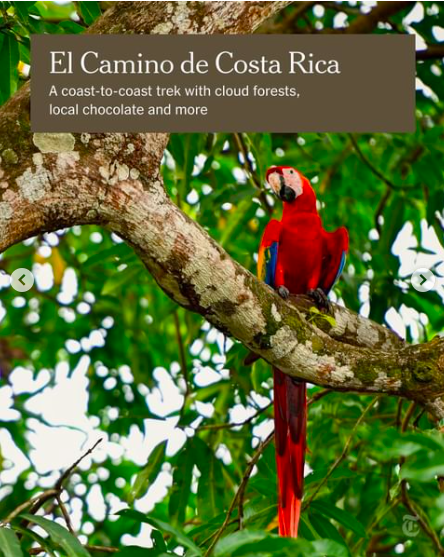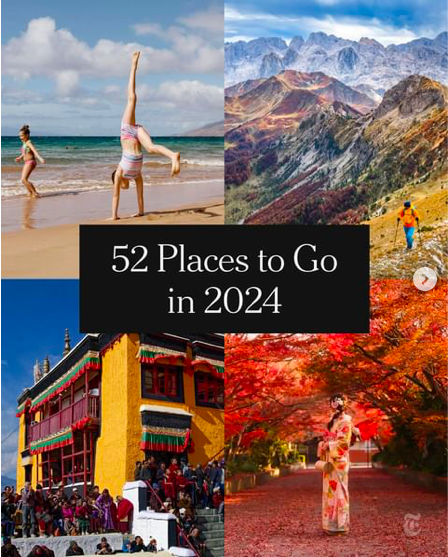El Camino de Costa Rica among 'The New York Times' preferred places to go in 2024.
- Costa Rica Luxury Travel Magazine

- Jan 9, 2024
- 4 min read
Updated: Mar 6, 2024
A coast-to-coast unique trekking adventure journey from the Atlantic to the Pacific through rural communities, mystic cloud forests, green valleys and magnificent rivers, where travelers immerse into the country's diverse tropical ecosystems with their own colorful flora and fauna, into indigenous cultures, and into authentic gastronomic experiences.
Images from The New York Times.
The New York Times selected 52 places not to be missed this year, and El Camino de Costa Rica, the 174-mile hiking route that connects the Caribbean and Pacific coasts, made it to this discerning list of inspirational travel destinations.
"With new signage, the Camino de Costa Rica, a 174-mile cross-country hiking trail that connects the Caribbean and Pacific coasts, became easier to navigate last year. Organized into 16 sections, the trail knits together 25 rural communities and terrain that ranges from beaches to cloud forests. The full hike can take from 11 to 16 days, and along the way, travelers passing through Indigenous areas can hire members of the Cabécar community as guides. The trail also traverses national parks and sanctuaries that host dazzling birds like the resplendent quetzal.
Trekkers can camp, book hotels or stay overnight with families, sampling homegrown coffee and chocolate as well as dishes like gallo pinto (beans and rice prepared with coconut milk). Local outfitters offer custom itineraries, including accommodations and luggage transfers, and activities like rafting, horseback riding and canoeing — all ways to help support areas off the tourist track."
— Nora Walsh, for The New York Times.
But, where exactly does El Camino de Costa Rica take us?
In the heart of Central America, where the Caribbean and Pacific coasts embrace the rich tapestry of Costa Rica's natural wonders, a remarkable trail awaits. El Camino de Costa Rica takes intrepid travelers on an extraordinary journey, weaving through diverse landscapes, unveiling hidden gems, and offering an immersive experience that captures the essence of this vibrant country.
El Camino de Costa Rica begins in the Carribean coast of Costa Rica (Atlantic) either in the town of Parismina or in the community of Barra del Pacuare. From both towns, hikers will take a boat ride to the Pier at Goshen where the walking adventure will start. The journey meanders through tropical jungles where the air is thick with the scent of exotic blooms and the sounds of howler monkeys echo through the canopy. The trail unfolds as an invitation to explore, embracing the laid-back rhythms of Caribbean life.

As hikers ascend into the central highlands, the landscape transforms. Rolling hills adorned with traditional villages characterize this region. Travelers will encounter locals who warmly share their stories, and witness the harmonious coexistence between the community and the land.
The journey ends in the town of Quepos on the Pacific coast. The last steps of the journey are marked by a beautiful mural of an octopus. Upon reaching the top of the stairs hikers know they have finally reached their destination by the marvelous sight of the Pacific Ocean in front of them. Each step taken unveils a new facet of this enchanting country, from the Caribbean's laid-back vibe to the Pacific's untamed beauty.

El Camino de Costa Rica was founded by a non-profit organization called Asociación Mar a Mar, dedicated to the conservation and protection of biodiversity, sustainable tourism, and the social and economic development of vulnerable communities. The organization's goals reflect such philanthropy:
Provide hikers with a route which includes an array of unique experiences, while appreciating the natural and cultural attractions of Costa Rica by means of a backcountry trail from the Atlantic to the Pacific ocean.
Ensure accurate information, signage and maintenance of the route as well as the values and standards of a long distance trail.
Help in the development of small rural businesses with a commitment to sustainability through its role as Community Fund.
Support sustainable development in small communities, through their artisans and local guides, therefore strengthening community organizations
Attract visitors from all over the world to appreciate the mountains, forests, rivers, valleys, and villages of Costa Rica, embracing its biodiversity.
Promote the protection of biodiversity and contribute to environmental education.
El Camino de Costa Rica is not just a physical journey but a cultural immersion. Encounter the warmth of Costa Rican hospitality, participate in local traditions, and learn from the communities that call these landscapes home.
As responsible travelers, we tread lightly on this journey, embracing sustainable practices and contributing to the conservation of Costa Rica's natural wonders. Engage with eco-friendly accommodations, support local initiatives, and leave only footprints behind.
El Camino de Costa Rica invites adventurers to not just traverse landscapes but to immerse themselves in the spirit of Pura Vida that defines Costa Rica—a journey that transcends the physical and becomes a transformative experience for the soul.
Lace up your hiking boots and explore the beauty of Costa Rica! One step at a time.
Original content by Costa Rica Luxury Travel Magazine
Sources: El Camino de Costa Rica and The New York Times












Comments